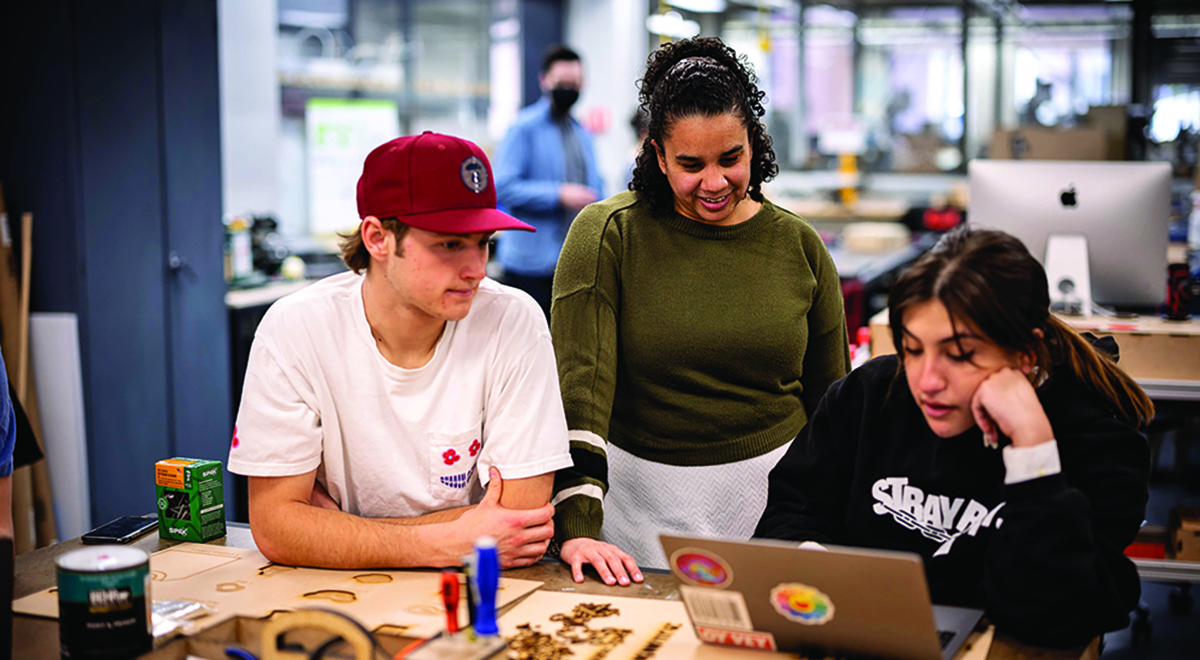Wesleyan Launches New College of Design and Engineering Studies

Wesleyan University has formed a new college that will challenge students to think and respond critically to the complex social, technological, cultural, and environmental conditions that surround them.
The new College of Design & Engineering Studies (CoDES) launched this semester. CoDES is home to the Integrated Design, Engineering, Arts & Society (IDEAS) minor and linked major. There are currently about 60 students minoring in IDEAS, a number expected to increase in the short term. Many of those minors will likely declare themselves majors in the college in the spring semester.
“At its core, we are interested in hands-on course work—learning through making. That is central to the studio model and to our engineering curriculum,” said Elijah Huge, associate professor of art and director of CoDES. “It will also be a fantastic hub for talking about questions of technology … how we, as humans, interface and interact with technology as makers.”
Huge is interested in training thinkers who can look at complex technological and artistic problems from unique perspectives. “We really value the fact that we’re in a liberal arts institution. I am excited that a student who is interested in being an artist, but also wants to learn about engineering, the sciences, or the social sciences, or that someone who wants to be both an engineer and a painter, can do so. We want to encourage students to have pathways to do that,” Huge said. “It is about building a conversation across disciplines.”
Project-based courses form the core of the IDEAS major and minor, Huge explained. Blending design studio, engineering lab, and research seminar formats, CoDES asks students to develop their work through iteration, encouraging open-ended exploration, thoughtful critique, and focused inquiry and testing.
CoDES also hosts the Engineering Dual Degree Programs. CoDES activities are centered around both the IDEAS Lab in the Exley Science Center and the Digital Design Studio in the Center for the Arts (CFA).
“We tried out this college as an experiment (through a preexisting IDEAS minor) to see if the students would come,” said Francis Starr, Foss Professor of Physics and one of the creators of the program. The IDEAS minor was spread over different divisions in the University and there was a sense that centralization would help. “We realized that there is a hunger from the students for this … it made sense to develop this college to provide a headspace and physical space for people who want to work at the intersection of all these different areas.”
IDEAS courses draw from a broad range of fields including biology, product design, ecological design, architecture, graphic arts, engineering, geology, archaeology, government, and physics. The hope is that students in the major will not only be able to cultivate needed skills, but more importantly, to learn a way of thinking that will enable them to think holistically about the grand challenges of society and offer solutions.
“The vision of the college (and its linked major and minor) is to think, feel, and ground design for a more equitable and sustainable future. We believe that this future requires a liberal arts education that integrates technological expertise, aesthetic understanding, and firm grounding in an ethics of social equity, mutual benefit, and reduced harm,” according to the proposal for the new college prepared by the IDEAS Proposal Committee.
“We have an iterative problem-solving approach where you have to keep working towards a solution—either there is no unique solution or there might be a lot of solutions on how to accomplish something … You have to design something and figure out why it failed and build on your failure. It’s a fail forward process,” Starr said.
Courses in the program will introduce a range of engineering and design practices, integrating these across Wesleyan’s liberal arts curriculum. The skills students develop can then be applied in countless settings—from design studios to science labs, from architecture and engineering offices to tech startups.
Balancing individual and group work, the projects the students will tackle frequently depend both on independent effort and collective capacity. In the classroom and beyond, students are encouraged to collaborate and to pursue opportunities for group work in an array of formats and contexts.
“I think we all recognize that our students need to go out and ultimately have a job,” Starr said. “But we don’t want to be a job training program. We want to be a mind training program in a way that is useful.”
“Students have long made these connections,” Huge said. “We have people on our Board of Trustees who have made these connections when they were students, studying both science and art and imagining how those fields could be combined. We’ve been working both to create a roadmap showing ways a student could productively do that and to expand the range of design and engineering opportunities available at Wesleyan.”

